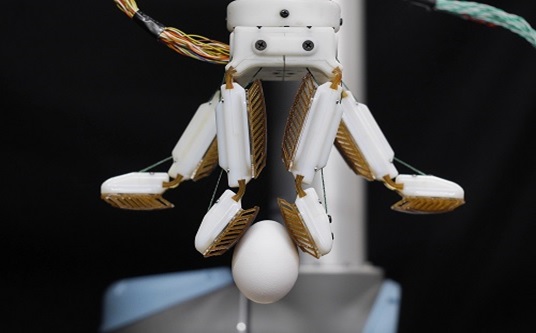Robotic Hand with Gecko-Inspired Strong Grip
A robotic hand is known to be powerful enough for firmly clamping and picking up a rigid object – no matter its weight.
But unlike human hands, robotic hands cannot distinguish between objects based on their composition. For instance, while a human hand can gently grip a tomato, a robotic hand will press it tightly and squeeze it, eventually ruining everything. A robotic gripper can’t do two things at once, that is, hold an object tightly and gently when required. Wide implementation of robots in manufacturing and our lives requires this problem to be corrected. [1]

Figure 1. Robotic Hand with Gecko-Inspired Strong Grip
Figure 1 The result of this goal is “farmHand,” a robotic hand developed by engineers Ruotolo and Dane Brouwer, a graduate student in the Biomimetics and Dextrous Manipulation Lab, at Stanford (aka “the Farm”) and detailed in a paper published Dec. 15 in Science Robotics. In their testing, the researchers demonstrated that farmHand is capable of handling a wide variety of items, including raw eggs, bunches of grapes, plates, jugs of liquids, basketballs and even an angle grinder.
FarmHand benefits from two kinds of biological inspiration. While the multi-jointed fingers are reminiscent of a human hand — albeit a four-fingered one — the fingers are topped with gecko-inspired adhesives. This grippy but not sticky material is based on the structure of gecko toes and has been developed over the last decade by the Biomimetics and Dextrous Manipulation Lab, led by Mark Cutkosky, the Fletcher Jones Professor in the School of Engineering, who is also senior author of this research.
Using the gecko-adhesive on a multi-fingered, anthropomorphic gripper for the first time was a challenge, which required special attention to the tendons controlling the fingers of farmHand and the design of the finger pads below the adhesive. [2]
From the Farm to space and back again
Like gecko’s toes, the gecko adhesive creates a strong hold via microscopic flaps. When in full contact with a surface, these flaps create a Van der Waals force – a weak intermolecular force that results from subtle differences in the positions of electrons on the outsides of molecules. As a result, the adhesives can grip strongly but require little actual force to do so. Another bonus: they don’t feel sticky to the touch or leave a residue behind.
The fuss is that the gecko adhesives must connect with a surface in a particular way in order to activate the Van der Waals force. This is easy enough to control when they are applied smoothly onto a flat surface, but much more difficult when a grasp relies on multiple gecko adhesive patches contacting an object at various angles, such as with farmHand. [3]
References:
- https://www.electronicsforu.com/news/whats-new/robotic-hand-gecko-inspired-strong-grip
- https://techiai.com/a-robotic-hand-with-a-gecko-inspired-grip/
- https://news.stanford.edu/2021/12/15/robotic-hand-gecko-inspired-grip/
Cite this article:
Thanusri swetha J (2021), Robotic Hand with Gecko-Inspired Strong Grip, pp. 41

